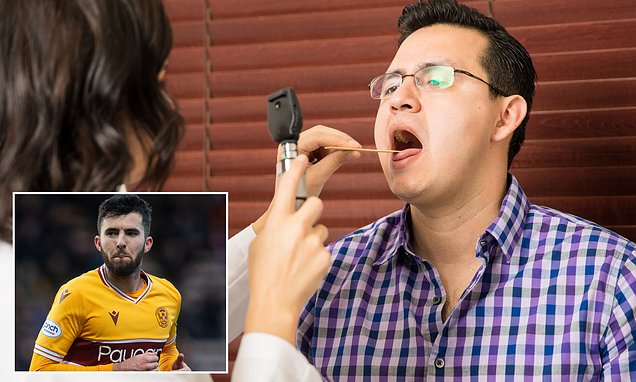Special string to help patients suffering painful throat condition
How eating special string could help sufferers of a painful throat condition which inflames the food pipe by avoiding the need for invasive scans
- The new technique was pioneered by experts at the University of Southampton
- It has been offered to patients who are suffering from eosinophilic oesophagitis
- The condition – which affects 1 in 1,000 people – causes pain in the throat
Thousands of people who live with a distressing throat problem could soon be spared frequent invasive scans – by swallowing a piece of string.
The new technique, pioneered by doctors at University Hospital Southampton, will be offered to patients with eosinophilic oesophagitis, a condition that affects roughly one in 1,000 people and causes the food pipe, or oesophagus, to become severely inflamed.
This can make eating uncomfortable, trigger nausea and in severe cases require an emergency procedure to remove blockages.
In February, Motherwell footballer Sean Goss, 26, revealed he suffered the condition.
If sufferers can’t swallow, they may have to rely on meal-replacement shakes for nutrition.

The new technique, pioneered by doctors at University Hospital Southampton, will be offered to patients with eosinophilic oesophagitis, a condition that affects roughly one in 1,000 people and causes the food pipe, or oesophagus, to become severely inflamed

In February, Motherwell footballer Sean Goss, 26, revealed he suffered the condition
The disease can be treated with drugs and by restricting foods that trigger the symptoms, but the only current method of monitoring involves having a camera inserted down the throat every two months.
This method, known as an endoscopy, can be gruelling but it is essential, allowing doctors to view the inside of the oesophagus and take tissue samples. If the condition advances, scar tissue can build up, permanently narrowing the pipe and worsening symptoms.
Now a new test, developed by UK doctors, could replace the uncomfortable but vital camera checks.
During a 30-minute procedure, patients swallow a 0.3mm-wide string, which is coiled into an 8mm ball. One end is taped to the side of the cheek. They take a swig of water and the string unravels in the stomach. After half an hour it is pulled out. The string is made of Rayon, a man-made fibre often used in soft furnishings that’s also highly absorbent. It soaks up fluid in the oesophagus, so instead of looking for physical damage, it allows doctors to check for microscopic inflammatory proteins.
In eosinophilic oesophagitis, infection-fighting cells called eosinophils go haywire and build up in the oesophagus. The area becomes inflamed, resulting in a feeling that the tube is tightening.
While many sufferers say having an endoscopy check is only mildly uncomfortable, a minority find it traumatic and require sedation. It can be particularly difficult for children. Dr Efrem Eren, a consultant immunologist at University Hospital Southampton who has used the technique on 1,000 cases, said: ‘Because the string is soft and springy like food, children as young as five have no problem swallowing it. What’s more, we have these testing devices in all NHS labs, so it would be easy to roll it out widely.’
The reason some people develop eosinophilic oesophagitis has long puzzled doctors. Many experts believe it to be the result of an unusually reactive immune system, as those with immune disorders such as asthma and food allergies are more likely to develop it.
Treatment includes cutting out common trigger foods, like wheat and dairy. Heartburn drugs called proton-pump inhibitors can also be effective, as can steroids. If left untreated, the oesophagus can become so narrow that patients have to have therapeutic dilation – where a balloon is used to widen the tube so that they can swallow.
Rarely, patients develop tears in the tissue that require emergency surgery to repair it.
Doctors at Southampton are encouraging patients to do the new test at home, to avoid trips to hospital. Dr Eren says: ‘Taking a test at home is an easy way to put them at ease that their treatment is keeping things under control – this may help to encourage them to stick to their treatment plans.’
Eli Rana, 13, from Southampton, has been monitored using the string test since he was first diagnosed with eosinophilic oesophagitis in June 2020. His mother, Lisa, an allergy awareness campaigner, had noticed he was having to cut up fruit and vegetables into tiny pieces and drink multiple glasses of water with his meals just to get the food down.
To confirm his diagnosis, Eli – who is interested in cars and photography – had an endoscopy and biopsy under general anaesthetic. During the following year, doctors at Southampton monitored his condition using the string test while he tried cutting different foods from his diet. Eventually, it was discovered that soya caused eosinophils to build up in his oesophagus.
His mother says: ‘I can’t even comprehend what it would be like if he couldn’t have the string test. It doesn’t hurt at all and he can be back in school an hour later – it’s amazing. I want Eli to have as normal a life as possible. It would be awful if he had to take regular days off school because of his health.’
Source: Read Full Article



